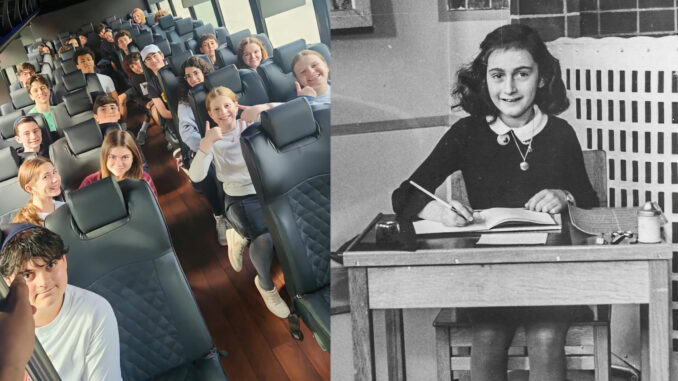
NEW YORK CITY—Teens from the Woodcliff Lake-based Valley Chabad Teen Leadership Initiative took part in a powerful and reflective visit to the Anne Frank Center Exhibit at the Center for Jewish History in Union Square on June 10.
Led by Rabbi Yosef Orenstein through Valley Chabad’s CTeen program, the experience offered students a meaningful opportunity to connect personally with Anne Frank’s story—leaving many inspired, prouder of their Jewish identity, and more committed to standing up for what is right.
The exhibit, on view through October, immerses visitors in Anne Frank’s life and legacy through multimedia, historical artifacts, and poignant excerpts from her diary. For many participants, the visit felt like more than a history lesson—it was a call to action.
“This trip made me realize that being Jewish isn’t just about religion,” said Mia D., one of the participants, via an update shared with Pascack Press. “Anne Frank did regular teenage things, like sports. Her story made me relate to her not just as a Jew, but as a teen. It made me prouder to be Jewish and to share her story.”
The trip is part of Valley Chabad’s broader mission to strengthen Jewish identity among local youth through leadership development, social action, and experiential learning.
“Seeing the Anne Frank exhibit with CTeen helped me understand that even when Jews were in hiding, they still tried to find joy and community,” said Ellie Berin of Upper Saddle River in the same update. “It made me want to unite more with others in the Jewish community today.”
Aaron Walker of Montvale added that the experience was transformative. “To be a Jew means to be compassionate, to pursue knowledge, and to have hope,” he said. “Despite everything Anne went through, she still believed people were good. I see that same hope in CTeen.”
The trip was made possible through the support of Simeon and Judy Hyman, in memory of Simeon’s mother, Gertrude Hyman, a”h.
Rabbi Orenstein emphasized the broader message: “This visit wasn’t just about remembering the past; it was about strengthening the future. Our teens left feeling more connected to their heritage and proud to carry their Jewish identity with strength and joy.”
Who Was Anne Frank?
Anne Frank was born in Frankfurt am Main, Germany, in 1929. As Hitler rose to power and antisemitic policies intensified, Anne’s parents, Otto and Edith Frank, moved the family to Amsterdam, where Otto ran a business that sold pectin and later, herbs and spices.
After Nazi Germany invaded the Netherlands in May 1940, Jews were increasingly restricted. In July 1942, following an order for Anne’s sister Margot to report to a forced-labor camp, the Frank family went into hiding in a concealed annex behind Otto’s office at Prinsengracht 263. They were soon joined by four others.
On her 13th birthday, just before going into hiding, Anne received a red-checkered diary. Over the next two years, she wrote about daily life in the “Secret Annex,” her thoughts and emotions, short stories, and passages she copied into her “Book of Beautiful Sentences.” Inspired by a radio broadcast from the Dutch government-in-exile, she began revising her entries into a single narrative, which she titled Het Achterhuis (The Secret Annex).
On Aug. 4, 1944, Anne and the others in hiding were discovered and arrested. Two helpers were also detained. The reason for the police raid is still unknown. Two other helpers rescued Anne’s writings before the annex was cleared by the Nazis.
After a period in an Amsterdam prison and the Westerbork transit camp, the group was deported to Auschwitz-Birkenau. Upon arrival, about 350 people from their transport were murdered immediately. Anne, Margot, and their mother were sent to a labor camp for women; Otto was separated into a men’s camp.
In November 1944, Anne and Margot were deported again—this time to Bergen-Belsen, where conditions were horrific: freezing weather, starvation, and rampant disease. Both sisters died of typhus in February 1945. Anne was 15. Their mother, Edith, had died earlier in Auschwitz. Otto Frank was the only member of the group to survive the war.
After the war, Otto returned to the Netherlands and learned that Anne had hoped to become a writer or journalist and intended to publish her story. In 1947, he fulfilled that wish by publishing her diary. The Diary of Anne Frank has since been translated into some 70 languages and adapted for stage and screen. In 1960, the hiding place opened as a museum: the Anne Frank House.
Until his death in 1980, Otto Frank remained devoted to sharing Anne’s story and fighting antisemitism, racism, and hatred in all forms.
The Anne Frank Center exhibit at the Center for Jewish History continues through October and is open to visitors of all ages.
For more information about Valley Chabad’s Teen Leadership Initiative, visit valleychabad.org or email Rabbi Yosef Orenstein at rabbiyosef@valleychabad.org.
